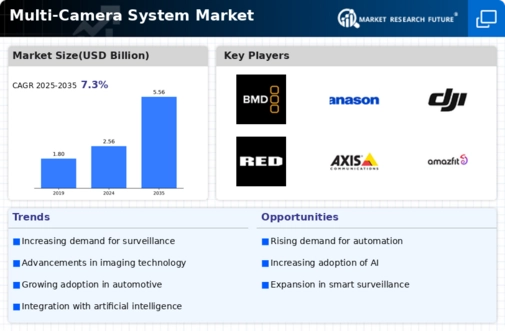Top Industry Leaders in the Multi Camera System Market
*Disclaimer: List of key companies in no particular order
Top listed companies in the Multi Camera System industry are:
Bosch (Germany), Continental (Germany), Delphi (UK), Magna (Canada), Samvardhana Motherson Reflectec (Germany), Valeo (France), Clarion (Japan), Texas Instruments (US), NXP Semiconductors (Netherlands), OmniVision Technologies (US), Xilinx (US), and Ambarella (US)
Competitive Landscape of Multi Camera System Market: A Panoramic View
The multi-camera system market is a dynamic space brimming with potential, propelled by rising demand for advanced surveillance, automation, and entertainment solutions. This intricate landscape unveils a diverse range of players vying for market share, employing distinct strategies to carve their niche. Delving into this panorama, let's dissect the key characteristics that define the competitive scenario:
Key Player Strategies:
Technology and Innovation: Market leaders like Hikvision, Dahua, and Bosch dominate the scene with their robust R&D capabilities, churning out cutting-edge camera technologies like AI-powered object recognition, advanced analytics, and low-light performance. Smaller players, though, leverage agility and niche specializations to develop innovative solutions for specific applications.
Partnerships and Acquisitions: Strategic collaborations and acquisitions are prevalent, fostering technology cross-pollination and market expansion. For instance, Axis Communications' partnership with Milestone Systems strengthens their VMS offerings, while Hanwha's acquisition of ONVU empowers its AI-powered surveillance solutions.
Vertical Market Focus: Players are tailoring their offerings to cater to specific vertical markets like retail, transportation, and healthcare. Honeywell, for example, excels in security systems for critical infrastructure, while Sony thrives in broadcast and live production multi-camera setups.
Cost-Effectiveness and Scalability: Mid-range players capitalize on cost-competitive solutions targeting budget-conscious segments. Hikvision and Dahua excel in this arena, offering feature-rich systems at attractive price points. Additionally, players emphasize modularity and scalability to cater to diverse deployment needs.
Factors for Market Share Analysis:
Brand Reputation and Market Presence: Established players like Bosch and Axis command brand loyalty and trust, holding significant market share. However, emerging players like Ring and Wyze are rapidly gaining traction with innovative offerings and disruptive pricing strategies.
Geographic Reach and Distribution Channels: Global reach and robust distribution networks provide a significant advantage. Hikvision and Dahua dominate in Asia, while Axis and Dahua have a strong presence in Europe and North America. Regional players often excel in their local markets due to stronger understanding of specific needs and regulations.
Product Portfolio and Technological Advancements: Offering a diverse range of cameras, software solutions, and value-added services like cloud storage and remote monitoring expands market reach. Continuous innovation in areas like AI, cybersecurity, and cloud integration is crucial for staying ahead of the curve.
Price-Quality Ratio and Customer Support: Balancing affordability with quality equipment and responsive customer support attracts budget-conscious buyers. Players like Dahua and Hikvision excel in this space, while premium brands like Sony and Panasonic cater to high-end segments with advanced features and top-notch service.
New and Emerging Trends:
Convergence of AI and IoT: Integration of AI-powered analytics and object recognition into multi-camera systems is transforming security and automation. Emerging applications like facial recognition, anomaly detection, and predictive maintenance are driving market growth.
Cloud-Based Solutions: The shift towards cloud-based video management systems (VMS) and remote monitoring solutions is gaining momentum, driven by scalability, accessibility, and cost-efficiency. Players like Vivint and Ring are leading this charge, targeting homeowners and small businesses.
Cybersecurity Focus: With increasing reliance on networked cameras and cloud storage, robust cybersecurity measures are paramount. Players are investing heavily in data encryption, access control, and vulnerability management to address growing security concerns.
5G and Edge Computing: The advent of 5G promises faster data transmission and real-time analytics, enabling advanced applications like remote surgery and autonomous vehicles. Edge computing empowers on-device processing, reducing reliance on cloud infrastructure and minimizing latency.
Overall Competitive Scenario:
The multi-camera system market is characterized by intense competition, with players continuously innovating and adapting to meet evolving customer needs. While established brands hold significant market share, smaller players are carving niches through specialization and disruptive pricing strategies. Technological advancements, particularly in AI and cloud integration, are shaping the future, driving demand for intelligent and interconnected systems. The emphasis on cybersecurity, vertical market focus, and cost-effective solutions are critical factors for success in this dynamic landscape. As players navigate the evolving terrain, the multi-camera system market promises continued growth and exciting new developments in the years to come.
Latest Company Updates:
Bosch:
- September 2023: Partnered with HERE Technologies to develop high-definition maps for AVs using multi-camera systems (Source:
Delphi:
- August 2023: Acquired a startup specializing in AI-powered video analytics for use in multi-camera systems for the automotive industry (Source: Delphi press release).
Magna:
- July 2023: Showcased a multi-camera surround-view system for passenger cars that can be integrated with existing ADAS features (Source: Magna website).
Valeo:
- May 2023: Launched a new surround-view camera system with enhanced night vision capabilities for premium vehicles (Source: Valeo website).

